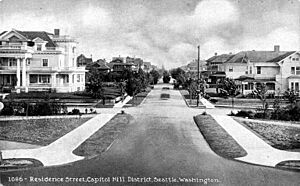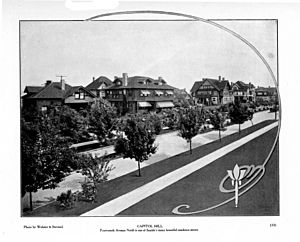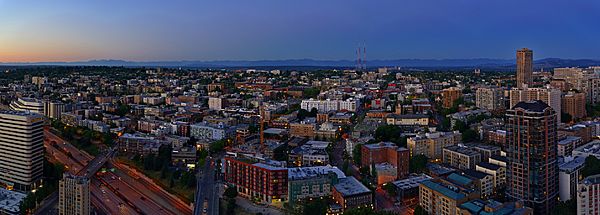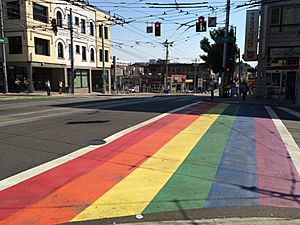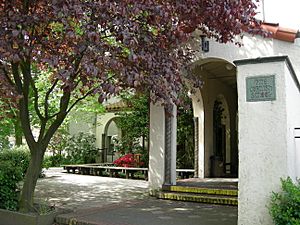Capitol Hill, Seattle facts for kids
Quick facts for kids
Capitol Hill
|
|
|---|---|
|
Neighborhood
|
|
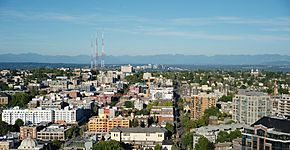
Capitol Hill as seen from 9th Avenue and Pine Street, looking east
|
|
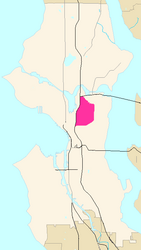
Capitol Hill's location in Seattle
|
|
| Country | United States |
| State | Washington |
| City | Seattle |
| City Council | District 3 |
| Neighborhood Council | East District |
| Police District | East Precinct, E1-3 |
| Established | February 4, 1886 (annexation by Seattle) |
| Founded by | James A. Moore |
| Named for | Potential state capitol |
| Area | |
| • Total | 1.64 sq mi (4.2 km2) |
| Population | |
| • Total | 32,144 |
| • Density | 19,600/sq mi (7,568/km2) |
| ZIP code |
98102, 98112, 98122
|
Capitol Hill is a busy neighborhood in Seattle, Washington, United States. It is located just east of Downtown Seattle. This area is known for its many homes and lively nightlife and entertainment spots. It is also home to a historic community that welcomes different cultures and ideas.
Contents
History of Capitol Hill
In the early 1900s, Capitol Hill was called 'Broadway Hill'. This was named after its main street. No one is completely sure how it got its current name. One story says that James A. Moore, a real estate developer, named it. He hoped the state capital would move to Seattle from Olympia. Another story says he named it after a neighborhood in Denver, Colorado, where his wife was from. Both stories might be true!
Capitol Hill has some of Seattle's richest areas. One famous spot is "Millionaire's Row" on 14th Avenue E. This area has large family homes on streets lined with trees. The neighborhood also has many beautiful apartment buildings. Some were designed by Fred Anhalt.
During the protests in 2020, an area near Cal Anderson Park became a protest site. It was called the Capitol Hill Autonomous Zone (CHAZ) by some.
Geography of Capitol Hill
Capitol Hill sits on a steep hill just east of downtown Seattle. It is bordered by Interstate 5 to the west. To the north are State Route 520 and Interlaken Park. South of it are E. Pike and E. Madison Streets. To the east are 23rd and 24th Avenues E.
The main street in Capitol Hill is Broadway. This is the center for many businesses. Other important streets include 10th, 12th, 15th, and 19th Avenues (running north–south). E. Pine, E. Pike, E. John, E. Thomas, and E. Aloha Streets run east–west. Many parts of these streets have shops and restaurants. The Pike-Pine corridor is especially busy with coffee shops, bars, and music venues. The neighborhood has many mid-rise buildings with a mix of businesses.
The highest point in Capitol Hill is in Volunteer Park. It is about 444 feet (135 meters) above sea level. Capitol Hill also has some of Seattle's steepest streets. For example, E. Roy Street has a very steep section.
Getting Around Capitol Hill
The Link light rail system has a station in Capitol Hill. It is called Capitol Hill station. This station opened in March 2016. The 1 Line connects the neighborhood to the University of Washington to the north. It also goes to Downtown Seattle to the south. The station is on Broadway.
The First Hill Streetcar line also stops in Capitol Hill. It opened in January 2016. This streetcar connects the neighborhood to other areas. Capitol Hill used to have city-run streetcars until 1940.
Buses are also available in Capitol Hill. King County Metro provides bus service. This includes electric trolleybuses. A new bus line, the Rapid Ride G, is being built along Madison Street. It will connect downtown Seattle, First Hill, Capitol Hill, and Madison Valley. This new line will have frequent buses.
Culture in Capitol Hill
Arts and Entertainment
Capitol Hill is known for its music scene. It was linked to the grunge music of the early 1990s. Today, you can find many types of music here. These include electronic, rock, punk, and hip hop.
The neighborhood is a popular spot for nightlife and fun. Many bars have live music. There are also many small theaters. You can find coffeehouses, taverns, and bars all over the Hill. Homes range from small apartments to large, historic mansions.
Capitol Hill also has two well-known movie theaters. These are the Harvard Exit (now closed) and the Egyptian Theatre. Both were once private meeting halls. The Northwest Film Forum is also here. It shows films, teaches filmmaking, and supports local filmmakers. These theaters host parts of the Seattle International Film Festival (SIFF) each year. The Broadway Performance Hall at Seattle Central College also has shows and lectures. The TV show Real World Seattle: Bad Blood was filmed here in 2016.
Since 1997, Capitol Hill has hosted the Capitol Hill Block Party. This is an outdoor music festival held every July. It takes place on Pike Street.
A "mystery soda machine" was in Capitol Hill from the late 1990s to 2018. It sold unusual drink flavors. People loved this quirky machine!
Coffeehouses
Capitol Hill has many famous coffeehouses. Besides big chains like Starbucks, there are local favorites. Espresso Vivace on Broadway is famous for starting the art of making fancy coffee designs. Starbucks even tested new coffee shop ideas in Capitol Hill.
Community and History
Capitol Hill has a long history of being a welcoming place for many different people. In the mid-20th century, it became a hub for people seeking a supportive community. This was especially true as other parts of the city changed.
Over time, many organizations were created in Capitol Hill to support the community. For example, the Dorian Society (now Seattle Counseling Service) opened in 1969. It was one of the first places to offer mental health support for young people. The Gay Community Center opened in 1974. In 1991, Lambert House opened to help young people. These places became models for helping youth.
For many years, Seattle's annual gay pride parades were held on Capitol Hill. The yearly festival still has block parties in the neighborhood.
The community faced challenges, especially during the HIV/AIDS epidemic. Cal Anderson, a state representative for Capitol Hill, passed away in 1995. Lincoln Reservoir Park was renamed in his honor. This park is a central part of the neighborhood.
In 2015, eleven permanent rainbow crosswalks were painted in the Pike-Pine area of Capitol Hill. In 2020, the plaza above the Capitol Hill light rail station became home to the AIDS Memorial Pathway. This is an outdoor art gallery that remembers those affected by HIV/AIDS. A street near the light rail station was also renamed E Barbara Bailey Way. This honors a local business owner and community activist.
Over time, Capitol Hill has changed. New buildings have been built, and more people have moved in. This has caused some members of the community to move to other areas of the city.
Landmarks and Institutions
Capitol Hill has many important landmarks. These include the Harvard-Belmont Landmark District. This district is home to the original building of the Cornish College of the Arts. Volunteer Park is another landmark. It has the Seattle Asian Art Museum and the Volunteer Park Conservatory. The Northwest School is also a registered historic place.
Besides Volunteer Park, other parks in Capitol Hill include Cal Anderson Park, Louisa Boren Park, and Interlaken Park. Lake View Cemetery is just north of Volunteer Park. It is where Bruce Lee and his son Brandon Lee are buried. The Grand Army of the Republic Cemetery is also nearby.
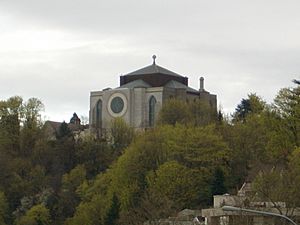
Many schools and colleges are on Capitol Hill. These include The Northwest School, Seattle Academy of Arts and Sciences, and Holy Names Academy. Seattle University and Seattle Central Community College are also here. St. Mark's Episcopal Cathedral is another important building.
Seattle's oldest African-American church is on 14th Avenue. The First African Methodist Episcopal Church was built in 1912. It was named a Seattle landmark in 1984.
The First Methodist Protestant Church of Seattle is listed on the National Register of Historic Places. It has been updated and is now used by a design company.
There is also a Jewish synagogue near Capitol Hill. Temple De Hirsch Sinai is just south of Madison Street.


